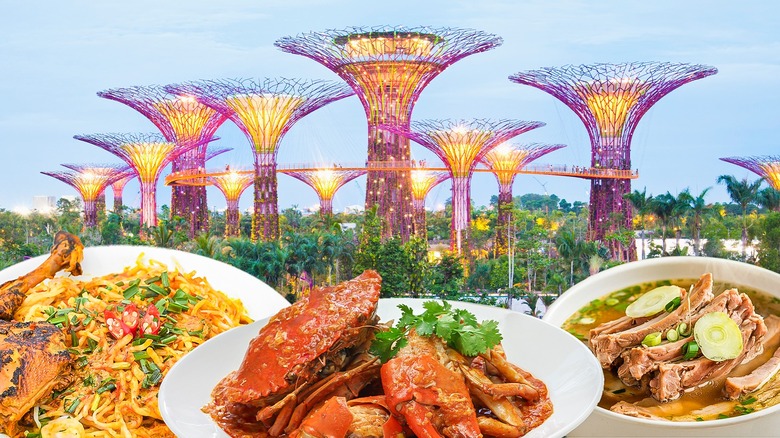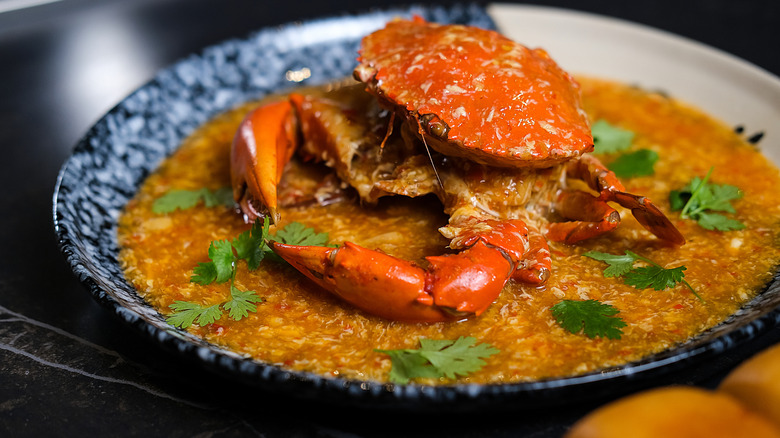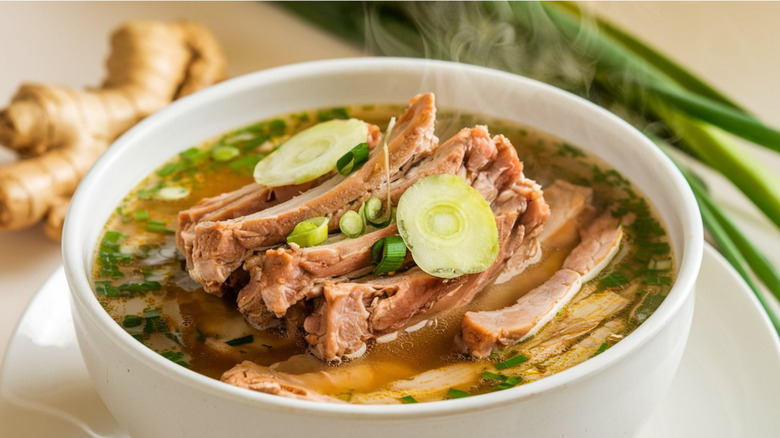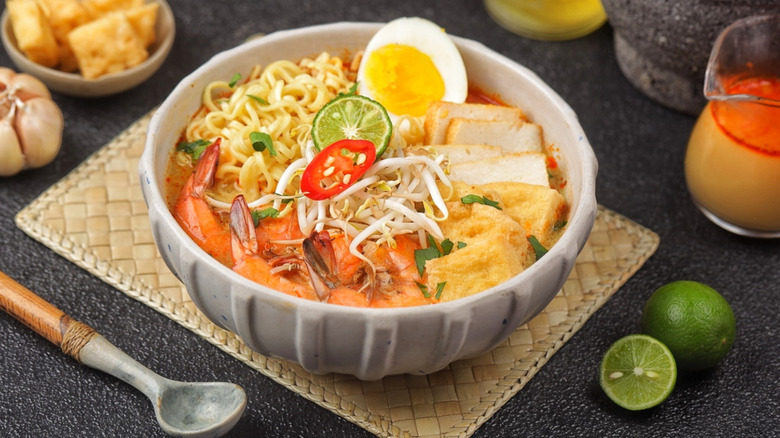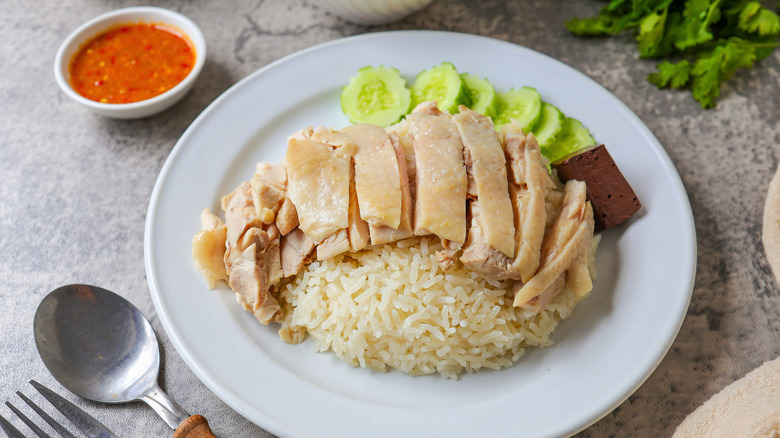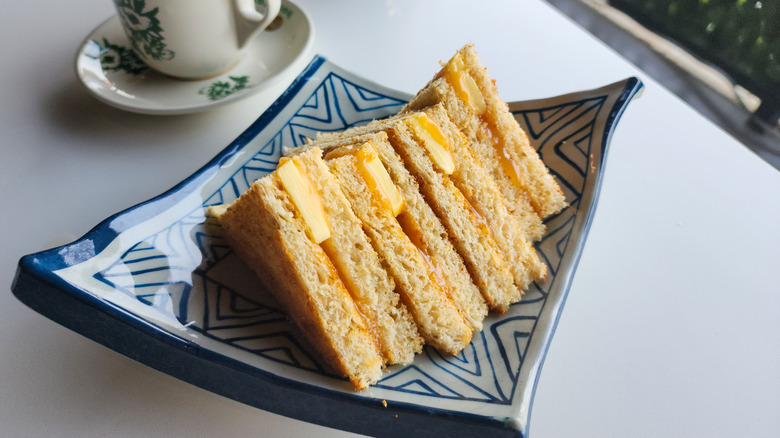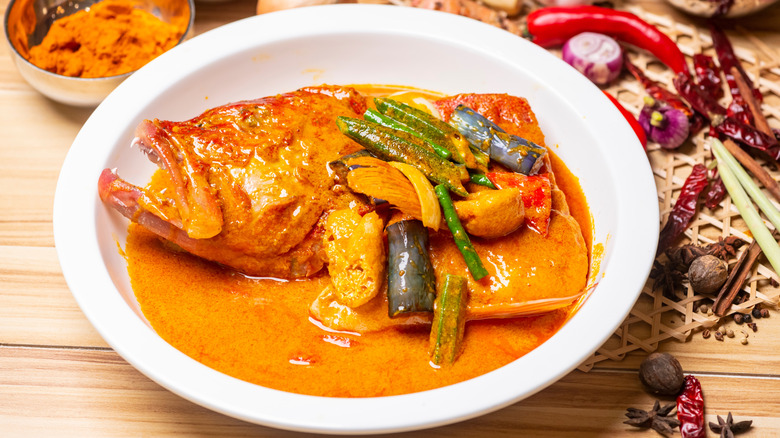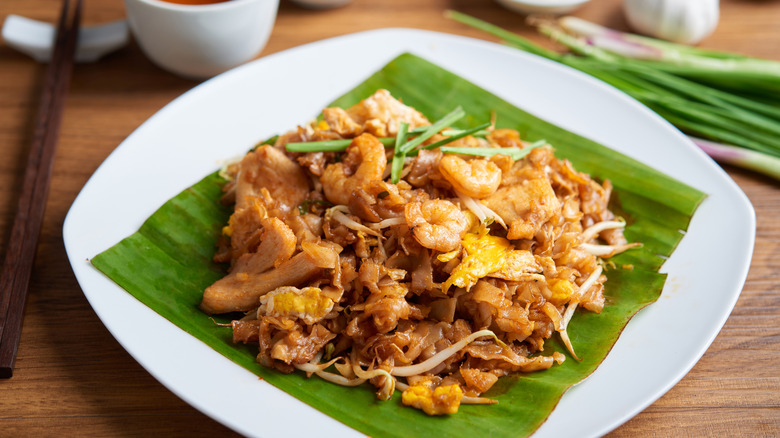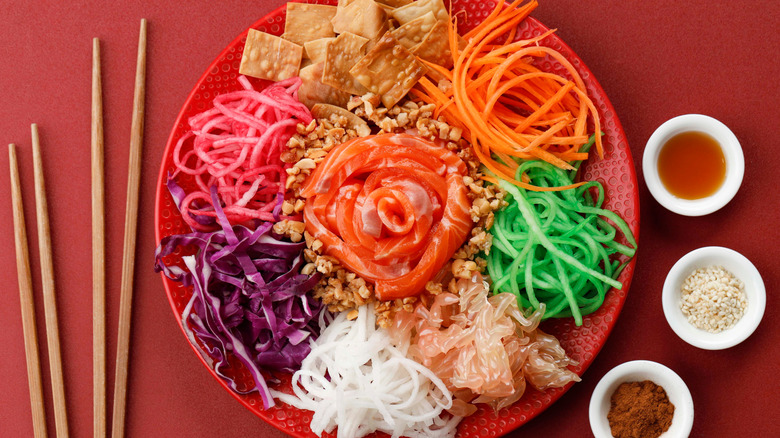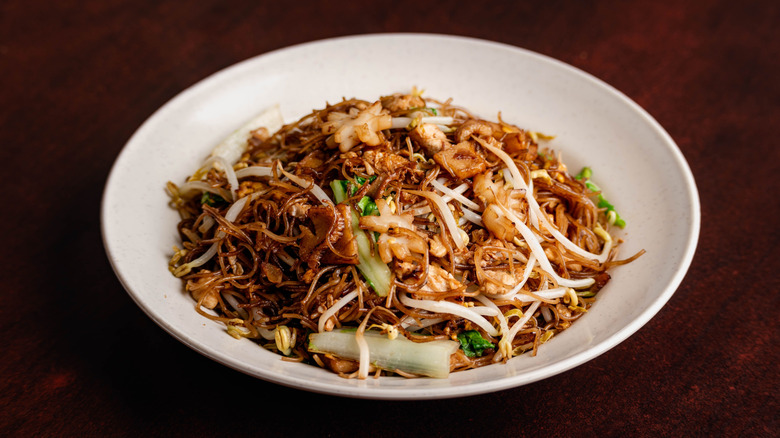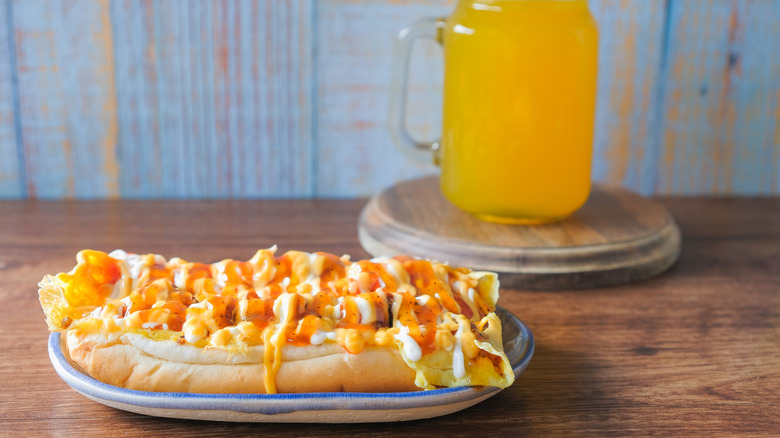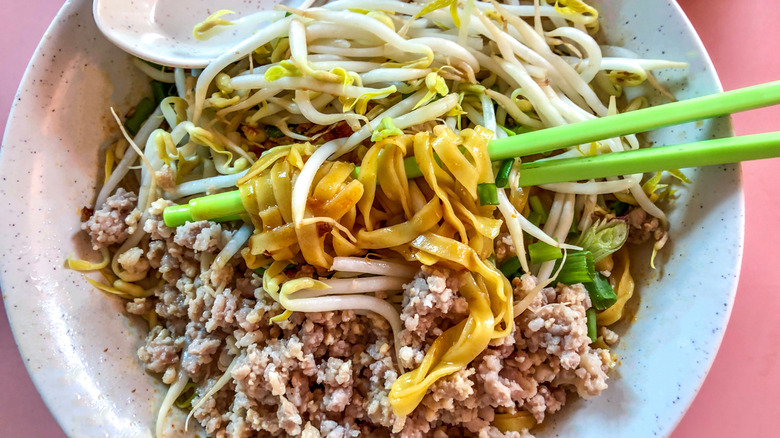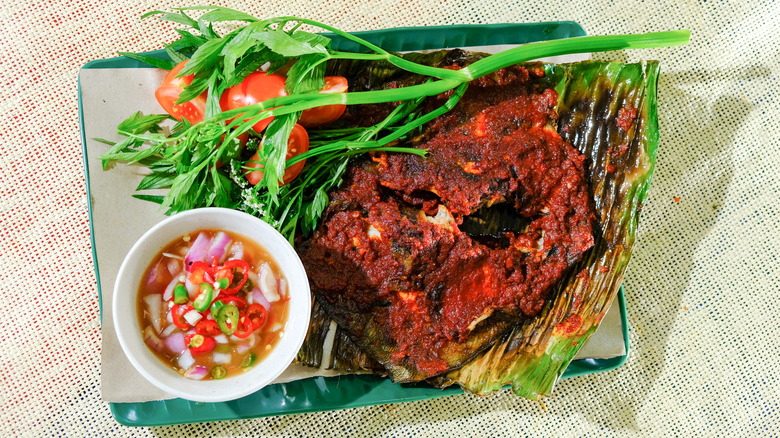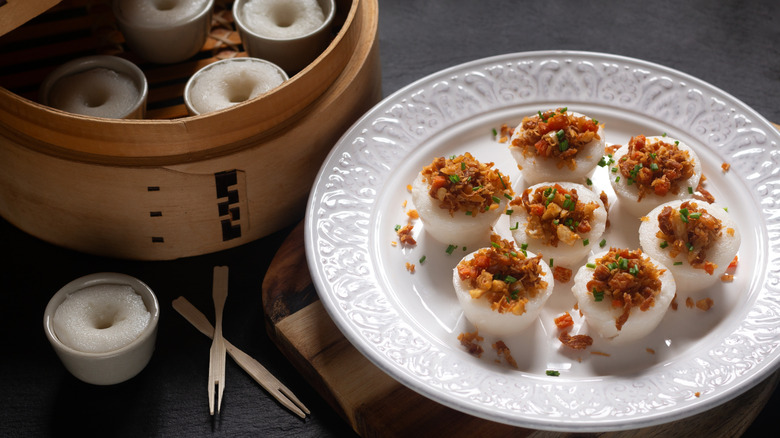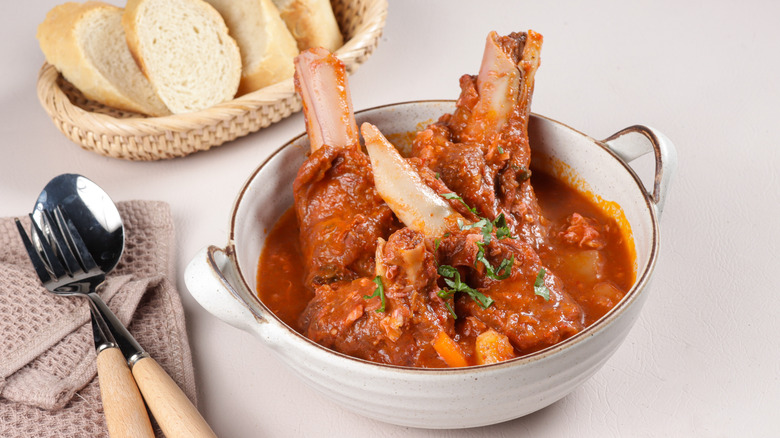14 Iconic Dishes From Singapore That Should Be On Your Radar
Singapore may be a small country, but it has one of the biggest, boldest food scenes on the planet. You can't walk more than a block or two on the island without coming across a cozy cafe, a Michelin-starred restaurant, or a hawker stall center. And it's not just the abundance of places to eat that make Singapore one of the world's best foodie destinations, it's also the creative dishes you'll find that fuse a wide range of flavors.
Located at the southernmost point of the Malay Peninsula, Singapore has always been at the crossroads of trade routes, and that has shaped both its cultural makeup and its culinary landscape. Peranakan cuisine, also called Nyona cuisine, is unique to the region and combines Chinese, Malay, and Indonesian ingredients and cooking techniques. Eat your way through Singapore and you'll also come across plenty of Indian and Eurasian influences.
Over the years, I've traveled to Singapore numerous times both for work (one of my previous jobs was writing for a Singapore food and lifestyle website) and pleasure. On each visit, I've had the opportunity to sample a vast array of Singaporean dishes, many of which were created on the island. If you're planning a trip or are just curious about what makes Singapore's food scene so special, these 14 iconic dishes deserve a spot on your radar.
1. Chili crab
Often called the national dish of Singapore, chili crab is a point of pride for Singaporeans. In fact, when a former Malaysian tourism minister suggested that the dish was actually Malaysian, many Singaporeans were seriously riled, including the woman who created it. In the early part of the 20th century, Cher Yam Tian would often steam mud crabs her husband Lim Choon Ngee brought home. One night he asked if she could switch things up, so she stir-fried the crabs in tomato sauce. He suggested a splash of chili sauce to cut the sweetness, and the dish was born.
Cher's chili crab was popular with everyone who tried it, so she started selling it from a push cart in 1950. Later, the couple opened a restaurant called Palm Beach Seafood and chili crab was one of the star dishes. Since then, many people have modified the recipe, so there are now several variations. One of the most popular includes sambal (a spicy chili sauce that also features in many Malaysian and Indonesian dishes) and egg whites. The sweet, savory, and spicy dish is often served with mantou buns.
2. Bak kut teh
Nothing is more comforting on a rainy Singapore day than a bowl of bak kut teh. The name translates to "meat bone tea," in the Hokkien dialect, but the dish is actually a hearty soup made with pork ribs and an array of herbs and spices. The exact origin of the soup is disputed, but many believe it was brought to Singapore by Chinese immigrants in the 19th century. Some say it was popularized by laborers who needed something nourishing to give them fuel for the hard physical tasks their jobs entailed.
Today, you can find several varieties of bak kut teh in Singapore, most of which include stock made with pork bones and meat. The Teochew version tends to be clear and lightly flavored with garlic and white pepper. Hokkien bak kut teh is darker thanks to the addition of soy sauce and spices like cloves, cinnamon, and star anise. The Cantonese style of the soup often includes an array of medicinal herbs. Some versions also have mushrooms, tofu, and bean curd skin. Bak kut teh is often served with rice, youtiao (fried dough fritters), and soy sauce on the side.
3. Laksa
Popular in Singapore, Malaysia, and Indonesia, laksa is a classic Peranakan dish that combines Chinese and Malay elements. Peranakan culture dates back to the 15th century when Chinese traders migrated to the Malay Peninsula and married into the local population. This resulted in the creation of unique dishes like laksa, which features rice noodles in a spicy curry-like gravy flavored with Southeast Asian ingredients like laksa leaves, lemongrass, galangal, candlenuts, chiles, coconut milk, and belacan (shrimp paste).
The best place to find traditional laksa in Singapore is in the historic neighborhood of Katong, a Peranakan enclave on the east side of the island. A typical bowl consists of slippery rice noodles swimming in a fragrant orange-hued gravy that's spicy, but also creamy from the coconut milk. Add-ins can include prawns, cockles, fish cakes, beansprouts, and hard-boiled eggs. You can also find laksa with chicken instead of seafood, fancy versions with lobster, and regional variations like asam laksa that swaps the coconut milk for a sour tamarind-based fish broth. Singaporeans love laksa so much that there are even laksa-flavored potato chips and instant noodles on the market.
4. Hainanese chicken rice
One thing that sets Singapore's food scene apart from anywhere else in the world is its hawker culture. Back in the day, hawkers used to roam the streets selling tasty eats from baskets or pushcarts. In the 1960s, the government began issuing licenses for hawkers and moved them into regulated spaces. Today, there are numerous hawker centers around the island where you can grab a wide array of dishes from a plethora of food stalls. One of the most popular is Hainanese chicken rice.
This succulent dish has its roots in wenchang chicken from Hainan province in China, but it evolved in Singapore. At first glance, it looks pretty basic — sliced chicken with rice. However, take a bite and you'll find that the chicken is extra tender and the meat and rice are infused with flavor. It's made by poaching chicken in stock until its just done, then cooking rice in chicken fat with garlic and simmering it in chicken stock with pandan leaves. The fragrant chicken and rice is sometimes drizzled with sesame oil and light soy sauce and often served with chili sauce, minced ginger, and thick soy sauce on the side.
5. Kaya toast
When it comes to breakfast in Singapore, it doesn't get much more traditional than kaya toast. Kaya is a sweet jam-like spread made from coconut cream, sugar, and eggs. Sometimes pandan leaves are included in the mix to give it subtle grassy vanilla notes. The kaya is typically spread on grilled or toasted bread with butter and served sandwich-style. And you can't have kaya toast without a steaming cup of kopi (coffee) or teh (tea). Some people also enjoy their kaya toast with soft-boiled eggs on the side.
There are a few theories about how kaya toast came to be. Some say that kaya, which is short for serikaya, was adapted from a Portuguese custard-like dessert called sericaia. Others say that immigrants from Hainan province who worked as cooks for the British created it based on Western jams and jellies. Yet others say the Peranakans created it. While the origin is disputed, we know that many Hainanese cooks went on to open kopitiams (coffee shops) in the early to mid-1900s, which is where kaya toast became popular and still is today.
6. Fish head curry
Being the cultural crossroads that Singapore is, you can find curries from around the world at restaurants all over the island, including vibrant Thai curries, warming Indian curries, and gulai-style curries from Indonesia and Malaysia. However, if you can only try one style while you're there, it should be fish head curry. This unique dish is a homegrown creation that fuses Indian and Chinese culinary influences. It's fragrant, fiery, and contains what some would argue is the most tender meat you can get from a fish.
In 1949, M.J. Gomez was running a food stall on Sophia Road and wanted to come up with a dish that would appeal to his Chinese customers. He knew that fish heads were a delicacy in Chinese cuisine, so he decided to tweak a traditional fish curry from his homeland of South India. His creation featured a fish head simmered in coconut milk with flavorful ingredients like ginger, garlic, tamarind, chilis, turmeric, and curry leaves. The dish was such a hit that now you can find countless variations in Singapore, some of which include additions like tomatoes, eggplant, and pineapple.
7. Char kway teow
Often served on a humble plastic plate at a bustling hawker stall, char kway teow is a deceptively simple noodle dish that delivers big on flavor. Char translates to "stir-fried" in Hokkien and "kway teow" is the type of flat rice noodle used in the dish. Although it's a dish that has taken on some Hokkien elements in Singapore, historians believe that Teochew people brought it to the Malay Peninsula from Guangdong province in China.
At its most basic, Singaporean char kway teow consists of flat rice noodles and yellow wheat noodles stir-fried in a hot wok with oil or lard, garlic, and sweet dark soy sauce. The screaming hot wok gives the noodles a charred, smoky flavor that makes the dish ultra satisfying. To amp it up, cooks often add a range of ingredients such as Chinese waxed sausages, cockles, prawns, bean sprouts, leafy greens, chives, and eggs. Depending on where you order it, you might find variations on the sauce with add-ins like umami-packed fish sauce or oyster sauce for extra sweetness. Many people also like to add chili sauce to give their char kway teow a touch of heat.
8. Yu sheng
Out of all the raw fish dishes around the world, yu sheng is one of the most elaborate. This colorful salad features thin strips of raw fish with shredded vegetables, chopped peanuts, crunchy crackers, sesame seeds, and a tangy sauce. It's typically eaten on the seventh day of the Lunar New Year and there's an elaborate ritual that goes along with constructing and eating it. The dish wasn't always so complex though. In fact, it was pretty humble in its early days.
The first mention of yu sheng (which translates simply to "raw fish") goes back more than 2,000 years to the Zhou dynasty in China. When it first appeared in Singapore via Cantonese and Teochew immigrants, the raw fish strips were tossed in oil and lime juice with just a few condiments like sesame seeds and ginger slices. It wasn't until the 1960s that a group of Singaporean chefs transformed it into the colorful creation it is today. It was around that time that diners also began tossing the salad together with chopsticks for good luck while making wishes for the New Year.
9. Satay bee hoon
If you're familiar with Southeast Asian satay, then you might be forgiven for thinking that satay bee hoon is a type of skewered meat grilled over charcoal. However, this hawker stall offering is actually a noodle dish. The satay part of the name refers to the flavorful peanut sauce the noodles are tossed in, while the bee hoon part refers to the thin rice vermicelli noodles. The dish often includes add-ins like cuttlefish, cockles, and kangkong (water spinach). You can also find versions with prawns, pork, and tofu puffs.
Satay bee hoon is an interesting dish in that no one seems to know exactly where it came from. Some say that it was brought to Singapore by Teochew immigrants from China, but the peanut sauce hints at Javanese influences. Others say it was an accidental creation that came to be when someone added leftover satay sauce to bee hoon noodles. Either way, it became a popular hawker dish. Sadly, the dish has waned in popularity over the past few decades and now there are only a few hawkers left selling it. Some say it's too time-consuming to make, not very cost-effective, and doesn't appeal to younger tastes.
10. Roti john
Roti john is Singapore's answer to the greasy, late-night sandwich. It's crispy on the outside, soft and savory on the inside, and can be doused in a variety of sauces. The sandwich typically consists of a French loaf filled with minced meat, onions, and eggs cooked omelette style. Some people also add sambal to the egg mixture to infuse some spice. The sandwich is often griddled so that the exterior is warm and toasty, then commonly served with condiments like mayo and chili sauce.
Like many Singaporean dishes, roti john was created thanks to a mingling of cultures. One legend states that an Indian hawker often sold omelettes in bread to British soldiers who frequented his stall after a night of drinking at the Union Jack Club. It got to the point where he would see them coming and ask, "Roti, John?" Roti means "bread" in Hindi and John was a term used to refer to Westerners. Another story states that the dish was created when an Englishman asked for a burger at a hawker stall and the vendor improvised with what was on-hand.
11. Bak chor mee
If there's one dish you're guaranteed to find at nearly any hawker center you visit, it's bak chor mee. The name translates to "minced meat noodles," and that's the essence of this dish. It typically includes springy yellow noodles with minced pork in a savory pork broth. Traditional add-ins include pork wontons, pork meatballs, fried shallots, and sliced scallions. You can also find dry versions of bak chor mee with a tangy sauce made of chili paste, soy sauce, and black vinegar instead of broth.
Bak chor mee was likely brought to Singapore by Teochew immigrants in the 19th century. At that time, vendors would carry baskets on poles that held all the ingredients and a charcoal stove. One of Singapore's longest running bak chor mee businesses was started by a vendor in the 1920s whose noodles earned the nickname "hunchback noodles," due to the vendor's hunched back developed from carrying the bak chor mee set-up. Famous Eunos Bak Chor Mee is now run by the great-great grandson of the founder, and he uses the original recipe that made the noodles famous over 100 years ago.
12. Sambal BBQ stingray
Sambal BBQ stingray is one of those dishes that surprises people in the best way. It's smoky, spicy, and kind of a hidden gem on hawker center menus. The best spots know how to cook this cartilaginous fish just right, choosing the meatiest parts of the stingray, slathering it in spicy sambal, and cooking it over hot coals until it's tender and juicy. The stingray is served on a charred banana leaf, which adds another layer of flavor to the dish.
Most of what makes BBQ stingray so great are the condiments. On its own, the meat can be rather bland, so it needs the sambal to kick it up a notch. Most vendors make their own sambal using a mix of fresh chilies, garlic, shallots, and belacan paste made from fermented shrimp. Then there is cincalok, another condiment that's served on the side, made from tiny shrimp that are fermented with salt and rice. The salty paste is often mixed with calamansi lime to add brightness to the picante stingray. Some spots also garnish the fish with sliced onions and cilantro.
13. Chwee Kueh
Swing by a hawker stall in the morning and you'll likely find several people chowing down on chwee kueh. The name translates to "water cake" and the dish consists of rice cakes topped with a mixture of preserved radish and garlic cooked in pork lard or oil. Some versions are savory and served with a dollop of chili sauce. Others contain sesame seeds and sugar in the filling, so they're on the sweeter side. Chwee kueh are often eaten for breakfast or as a snack.
Chwee kueh may look simple, but there's an art to making them right. You need the right proportions of rice flour, tapioca flour, and water to create a cake that's light and soft with just a bit of wobble to it. In addition, the cakes should steam until water is released in the center, causing a depression where it pools. That's why they're named "water cakes." Then there is the filling, which should be tender with some bite and a good balance of flavors — either salty and spicy or savory and sweet.
14. Sup tulang merah
Bright red, saucy, and unapologetically messy, sup tulang merah isn't the most graceful dish to eat. However, many locals will tell you it's seriously shiok (the Singaporean term for delicious). Also called sup tulang, the name means "red bone soup," and it consists of mutton or beef bones that are simmered for hours with spices, tomatoes, and sambal. The sauce-slathered bones are typically served with a French loaf on the side to help mop up all the sweet and spicy sauce. Many say the marrow is the best part.
Sup tulang merah is unique to Singapore, having been created there in the 1950s. Most sources agree that it was first made by a man named Abdul Kadir, who ran an Indian Muslim food stall. One day, a customer asked Kadir to make something with the leftover mutton bones that were used for another dish called mee kuah, so he created a saucy side dish with the bones. The spicy, slurp-worthy creation took off, and now you can find numerous hawkers serving it. The Golden Mile Food Center has several stalls that sell sup tulang merah, each putting its own twist on the recipe.
